Registered in 1976 Rapture has proven to be a great and enduring flower in div. 6, yet Daffseek lists no descendants from it. The non-miniature div. 6’s are typically a cross between a tetraploid main division flowers and diploid cyclamineus i.e. they are usually triploid. There is no established pool of tetraploid div. 6’s that can be crossed with each other and hence the division is fraught with fertility problems.
Two great triploid breeding flowers come to mind: N. poeticus var. recurvus and Mary Copeland and I suspect that both illustrate the uncertain fertility that follows from triploids – it is not the case that they reliably pass on either one set or three sets to their offspring. Falaise, with 26 chromosomes but a reliable parent of tetraploids, is a good illustration. Obtaining tetraploids with regular fertility from triploids looks like a numbers game and much disappointment is to be expected.
In div. 6 just a few triploid parents come to mind – Jetfire, Jenny and the curiously triploid Beryl. Of these Jenny, particularly through Joybell and Foundling, seems to be establishing itself in pedigrees of (presumably) tetraploid flowers.
Nodding poise and reflex are not exclusive characteristics of cyclamineus and it seems obvious that division 6 can be bred without the aid of it. Perhaps Lilac Charm is one such.
Lilac Charm is interesting not just as a tetraploid div. 6 but also for its color, but according to Daffseek only David Jackson has registered a descendent from it this century. Clearly this is a difficult area of breeding.
Lilac Charm x (Merry Princess x Radcliff 2W-P)
(Merry Princess x Radcliff 2W-P)’ x (Lilac Charm x Radcliff 2W-P)
The breeding of div. 6’s without cyclamineus doesn’t seem to have been pursued, but I recall Harold Cross in the early 90’s bringing some strongly reflexed 2Y-R’s to Perth – perhaps from Falstaff. It may be that such flowers have been regarded as too large and gross.
(Top Notch x Reference Point) x (Tristram x Flashing Light)
Reference Point x 02/191
Altun Ha x (Chiloquin x Impeccable)
Twilight Zone x Impeccable
[Capree Elizabeth x (Abona x Chiloquin)] x [Baldock x (Pastiche x Lemon Haze)]
Goldfinger x (Inca Gold x Impeccable)
(Abona x Chiloquin) x (Reference Point x Impeccable)
My feeling is that smaller triploid flowers are preferred in division 6, which is why the idea of creating an intermediate class in this division seems more likely to create a niche for larger division 6’s than a niche for the many diploids that are too large to be miniature. Smaller triploids and tetraploids are being bred so the hard fact is that there seems to be no place for large diploids no matter how elegant.
My own experience is limited. I had hoped to artificially produce tetraploid cyclamineus and in that way bypass the triploids. Consequently I have only dabbled a little with triploids. Seedlings from Tracey have been unimpressive and none have been obviously diploid or tetraploid. Many triploids are low percentage parents – here, for example, just few seeds from a number of seedlings from Pink China and Rheban Charm crossed with Swagger x cyclamineus. This year a not-lovely Terminator x cyclamineus had good seed set so perhaps it can produce the numbers needed to get good tetraploids (or well colored diploids). 99/5D may be effectively tetraploid, probably The Little Gentleman x Dear Me.

I wrote in a confidential survey many years ago that if the the process of producing artificial tetraploids succeeded we could see miniatures in all color codes by 2010(?). That process did not succeed for me but in 2006 a putative tetraploid cyclamineus x Swedish Fjord flowered that was fully fertile and obviously tetraploid.
The absence of strong reflex makes one wonder if the pedigree is correct or whether it is 1 part cyclamineus and 3 parts Swedish Fjord. If I ever had tetraploid cyclamineus then it is doubtful I still have it. A couple of open pollinated (?) seedlings from that plant flowered this year and these are borderline miniature.
The near miniature 2Y-O seedling illustrated in the March journal did not flower this year, which illustrates the lack of vigor in these plants. But the broader picture is that in division 6 and divisions 1-3, the advance of tetraploids into the miniatures is happening. In this respect John Reed’s recent registration of Wee Fergie is very interesting. It would be very interesting to know the details of its fertility. In division 6, John Hunter’s Flight Path also looks very interesting.

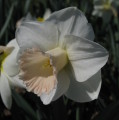
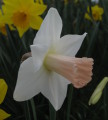
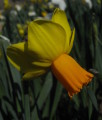


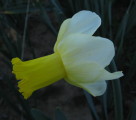
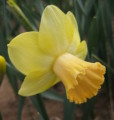

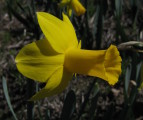
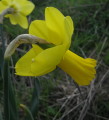
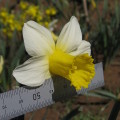
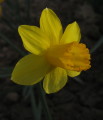

Lawrence,
A very interesting and comprehensive posting pointing out difficulties that many of us have experienced.. Ref. ‘Lilac Charm’ I’ve tried using it as a seed parent over many years and I could count the seeds obtained on the fingers of both hands! But used as a Pollen parent the prospects are much better using tetraploid standard daffodils – I still have to flower seedlings from Lilac Charm onto small cyc. hybrids (that I suspect are still diploid as they have come from species or CAndlepower etc.)
I’d recommend the Dutch raised ‘Maria’ 6Y-R (just slightly larger than Jetfire( as it is fully fertile and has given me good colour when crosed with N. triandrus concolor. Now I have a lot of seeds N. cyclamineus x ‘Maria’ planted. I think it is time to go back to ‘Foundling’ x miniatures!
Brian
Hi Brian,
Good to hear from you!
I seem to have obtained a reasonable number of seeds from Lilac Charm but none as a pollen parent. Perhaps I simply haven’t tried it. I’ve updated the post to include some photos.
In the pipeline is a more purely and strongly colored sibling to 09/240 back crossed onto Lilac Charm. Hopefully that will yield something miraculous.